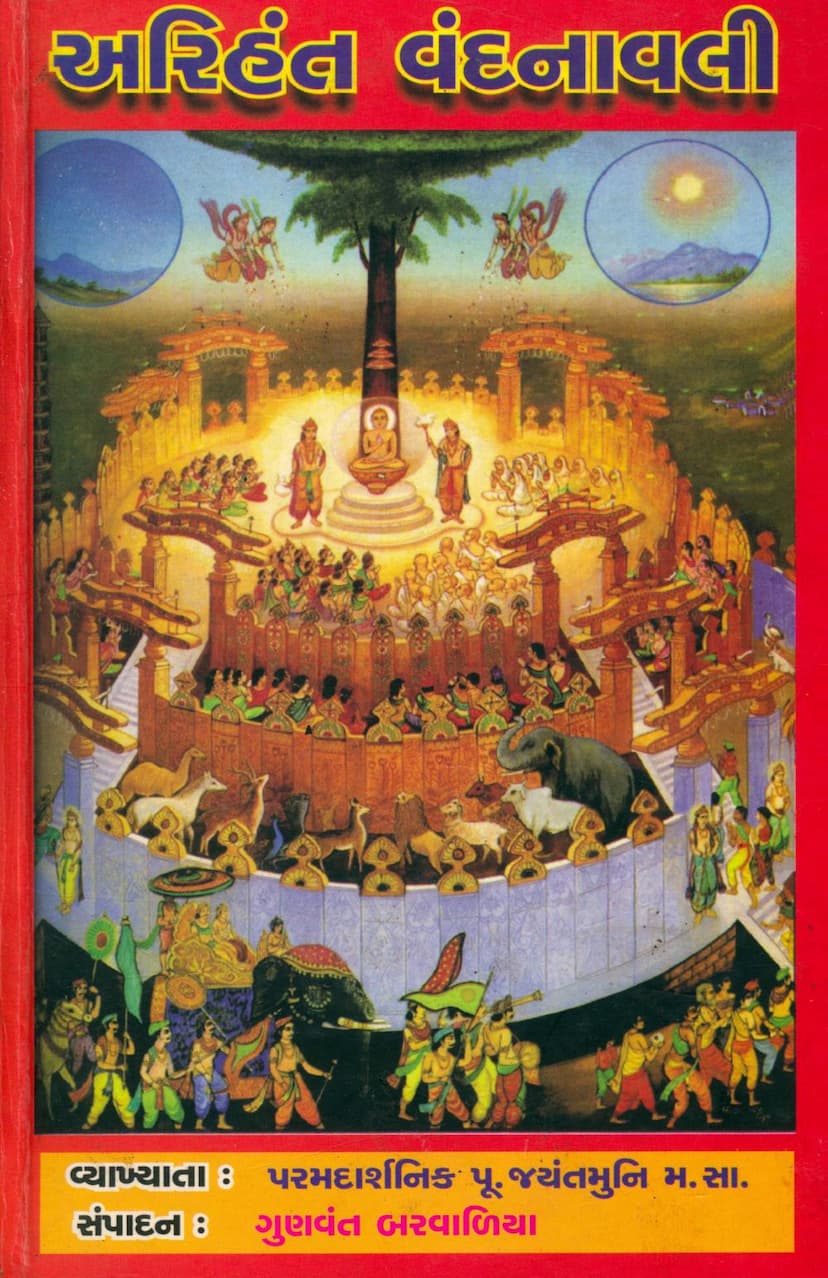Arihant Vandanavali
Added to library: September 1, 2025

Summary
This is a comprehensive summary of the Jain text "Arihant Vandanavali" based on the provided pages:
Book Title: Arihant Vandanavali Author(s): Jayantmuni, Gunvant Barvalia (Editor) Publisher: Kalptaru Sadhna Kendra
Overall Theme:
"Arihant Vandanavali" is a collection of discourses and devotional verses that focus on the veneration and glorification of Arihants, the enlightened beings in Jainism. The text emphasizes the profound significance of worshipping Arihants, highlighting how such devotion can transform one's destiny from mere fortune to supreme good fortune. It presents Arihants as beings of immense purity, brilliance, and depth, embodying the ultimate spiritual realization.
Key Aspects and Content:
- The Nature of Arihants: The text repeatedly describes Arihants as being "more radiant than the moon," "more brilliant than the sun," and "more profound than the ocean." They are depicted as beings who illuminate the entire universe and possess infinite virtues and powers.
- The Significance of Vandan (Veneration): The book stresses that while hearing the name of the divine is a blessing, true auspiciousness comes from actively venerating the Arihants. The verses within the "Arihant Vandanavali" are said to evoke auspicious spiritual sentiments within the soul.
- The Role of Pujya Jayantmuniji: The discourses and insights of Pujya Jayantmuniji are central to this work. His profound philosophical understanding and spiritual depth are credited with unveiling the inner meanings of the "Arihant Vandanavali," making the verses resonate deeply with the reader from their eyes to their heart, and from their ears to their mind.
- The "Arihant Vandanavali" Composition: The text clarifies that "Arihant Vandanavali" is primarily a veneration of the first verse of the Namaskar Mantra, specifically focusing on the "Arihant" aspect. While all five verses of the Namaskar Mantra are equally venerable, this particular composition emphasizes the Arihant. The verses describe the Arihant's splendor, external divine paraphernalia (pratiharya), and their inherent powers and miracles.
- Praise for the Gujarati Translation and Commentary: The work acknowledges the translation of the original Prakrit composition into Gujarati by "Shri Chandra" (Chandumal Shankarchand Shah), who is described as a devoted and knowledgeable follower of Jain philosophy. The editor, Gunvant Barvalia, is also commended for his efforts in compiling and editing the work, making it accessible to a wider audience.
- Inspirational Origin: The book's creation was inspired by the practice of venerating Arihants by senior Jain monks and nuns, particularly Pujya Lalitabai Mahasatiji and her disciples, who would perform the "Arihant Vandanavali" prayer every month. The profound inner joy experienced during these prayers is highlighted.
- The "Panchang Bhav" Vandan: A recurring theme is the "Panchang Bhav" (worship with five limbs: two hands, two feet, and the head). The verses repeatedly mention performing this type of worship, emphasizing the complete surrender and devotion offered to the Arihants.
- Detailed Description of Arihant's Life and Attributes (Through Verses): The majority of the provided text consists of detailed explanations and interpretations of individual verses (Gathas) of the "Arihant Vandanavali." These verses cover a wide range of aspects related to the Arihants, including:
- Conception and Birth: The auspicious dreams of the mother, the adoration by celestial beings (Indras) during birth, and the divine celebrations.
- Divine Attributes: Descriptions of their purity, radiance, power, knowledge, and the perfection of their physical form.
- Royal Life and Renunciation: Their celestial court, the use of divine paraphernalia, their adherence to principles of righteousness and detachment, and ultimately their renunciation of worldly life.
- Spiritual Practices: Their austerities, adherence to vows, control over senses and mind, and the practice of meditation.
- Symbolic Representations: Comparisons to natural elements like lotuses, clouds, the sky, elephants, lions, the ocean, and the moon, to illustrate their virtues.
- The Trinity of Virtues: Emphasis on Knowledge (Gyan), Perception (Darshan), and Conduct (Charitra) as the core of their spiritual attainment.
- The Fourfold Community: The establishment of the monastic order (Sangh) comprising monks, nuns, laymen, and laywomen.
- The Path to Liberation: The journey towards achieving the state of Siddhahood, the ultimate goal of liberation.
- The Role of the Guru: The importance of spiritual guidance from the Arihants.
- The Translator and His Journey: The text includes biographical information about the translator, Shri Chandulal Shankarchand Shah, highlighting his early life, his pursuit of worldly knowledge, his eventual spiritual awakening prompted by his mother, and his dedicated study of Jain scriptures under the guidance of gurus. His realization of the profound beauty of "Arihant Vandanavali" during his spiritual practice is a key part of his narrative.
- The Importance of Faith and Devotion: The text underscores that even a small amount of devotion, when coupled with unwavering faith, can lead to immense spiritual benefit and liberation.
- Thematic Structure: Each verse (Gatha) typically concludes with the refrain of "Panchang Bhav" (worship with five limbs) to the Arihants, reinforcing the central theme of devotion.
In essence, "Arihant Vandanavali" is a devotional text that seeks to elevate the reader's spiritual consciousness by presenting the sublime qualities and life story of the Arihants, encouraging sincere veneration and contemplation of their path to ultimate liberation.